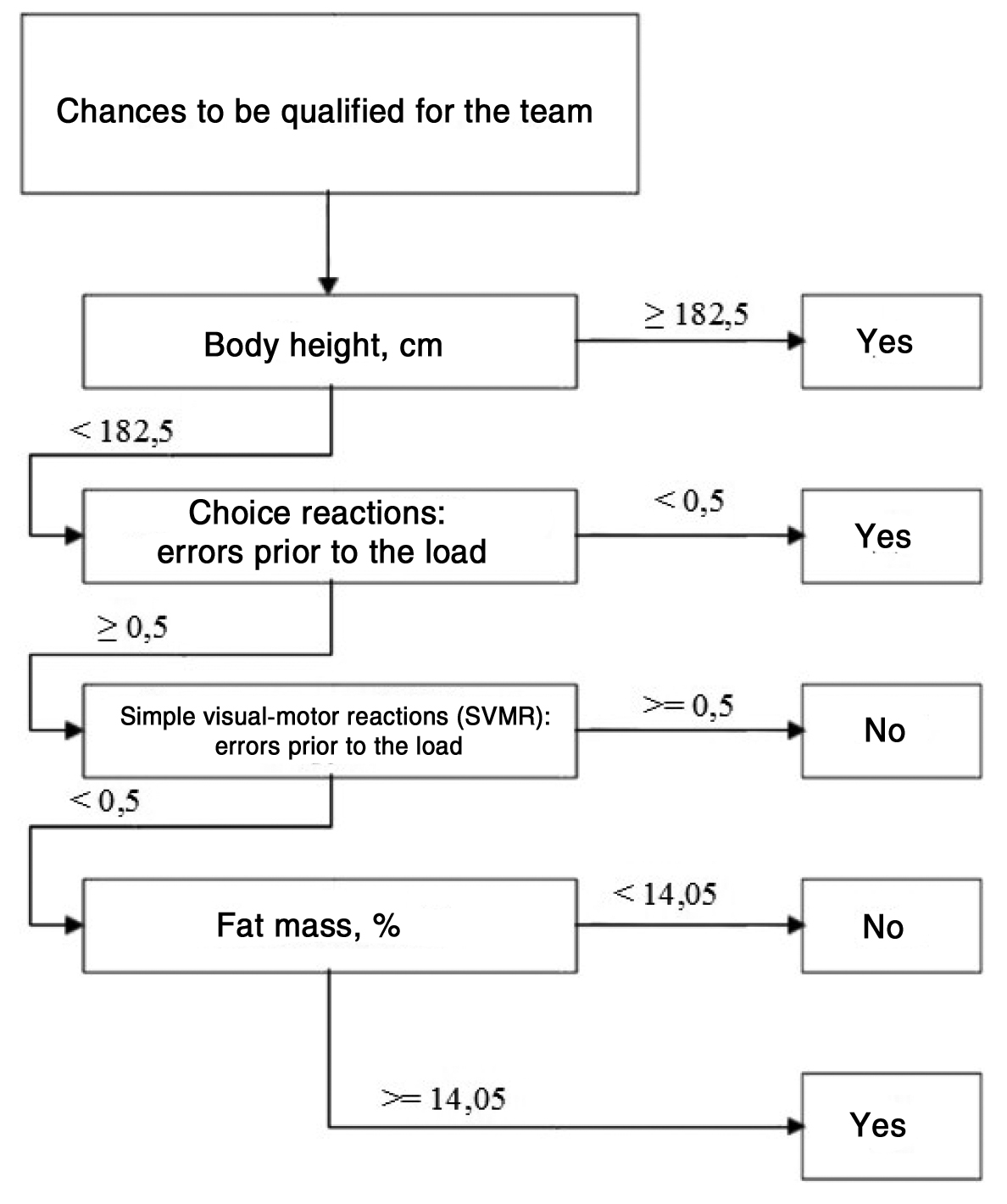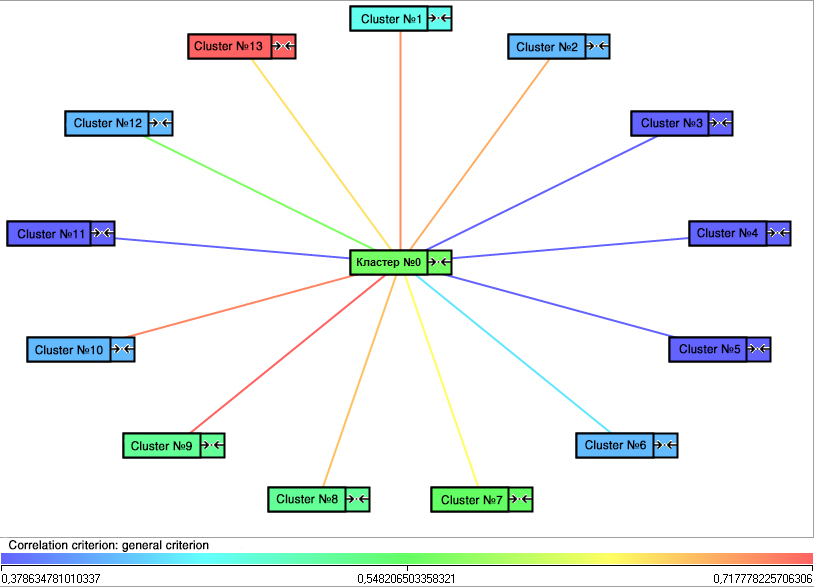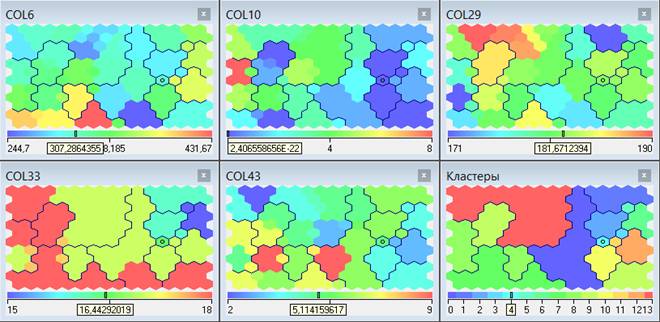15-16-year-old ice hockey players' qualification criteria
Фотографии:
ˑ:
PhD E.A. Reutskaya1
PhD N.V. Pavlova1
PhD O.S. Antipova1
Dr.Hab., Professor V.A. Aikin2
PhD, Associate Professor А.В. Korichko3
1Extreme Environments Research Institute under Siberian State University of Physical Culture and Sports, Omsk
2Siberian State University of Physical Culture and Sports, Omsk
3Nizhnevartovsk State University, Nizhnevartovsk
Keywords: ice hockey, qualification, forecasting, individualisation, solution tree, Kohonen cards.
Background. Objective of a quality qualification process is to rate athlete’s potential to identify if he/she can achieve the best international performance standards in the sport provided the individual resources are mobilised to the maximum [1, 2 et al.]. As things now stand, very few students of Children’s and Youth Sport Schools and special Children’s and Youth Olympic Reserve Sport Schools are being qualified for the professional teams i.e. the sport schooling system efficiency is still low [4, 6 et al.]. Therefore, due attention is to be given to the initiatives to improve educational qualification technology and find the most grounded and efficient performance rating criteria for the qualification process.
Objective of the study was to develop and substantiate the most efficient performance rating criteria for the ice hockey player to be qualified as a first-stringer.
Methods and structure of the study. The study was initiated pursuant to the Ministry of Sports of Russia Order #1247 of 25.12.2015 on Siberian State University of Physical Culture and Sports being awarded a state contract for the period of 2016 – 2018 for the “Improvement of the educational process management technology in long-term ice hockey training” studies. The study was performed at the Extreme Environments Research Institute under Siberian State University of Physical Culture and Sports.
The study methodology was designed to obtain empirical data on anthropometrical characteristics; functionality test rates; psycho-physiological test rates; and physical working capacity rates of the subject 15-16 year-old players. The players' psycho-physiological adaptation rates versus time and summarised physical loads were tested at relative rest and on the tenth minute of recovery after the cycle ergometer tests. In order to find the key factors of influence on the chances of athletes to be qualified as first-stringers, we applied the relevant solution tree with algorithm С4.5 based on a hierarchical model and the relevant decision-making rules [7 et al.]. Data processing under the study was performed using Deductor Studio 5.3 software [5 et al.]; with the test data analyzed using the Kohonen cards applied to study the statistical data array with a fair accuracy, classify the subjects into clusters based on the preset parameters, find regularities and visualise the outcome analytical data [3 et al.]. It should be noted that the relevant factor variability across the clusters was rated by the colour indices showing the factor variation degrees across some clusters. Moreover, the higher is the variability the wider is the colour variation within the cluster. Data processing under the study was performed using Deductor Studio 5.31 software, with the modelling accuracy estimated at 93%. A data profile was generated for each cluster, with the statistical data being computed using the profile (significance rate, %; x; σ; m) for every subject parameter.
Study results and discussion. Having designed the solution tree (Figure 1) to qualify 15-16 year-old prospects for an ice hockey team, we estimated the average modelling accuracy at 89% for the subject age group.

Figure 1. Solution tree designed to qualify the 15-16 year-old prospects for ice hockey teams
Athlete’s height was proved to be the most important rate (32.46 %) in the solution tree for qualifying the 15-16 year-old prospects for the ice hockey team; followed by almost same important fat mass rate (25.11%) and error rate in the simple visual-motor reactions (SVMR) at relative rest (24.24 %).
It should be noted that each team is naturally prone to develop its own prospects’ qualifying strategy albeit among other factors of the qualification process a high priority will always be given to the ice hockey player’s body height. It was found that the 182.5cm-plus-high prospects have higher chances for success in the junior and continental hockey leagues. Furthermore it was found that the fat mass in excess of 14% should be considered a limiting (disqualifying) factor as a predictor of potential de-adaptation conditions for the 15-16 year-old players. We should also note the following: the lower is the error rate in the above tests, the higher is normally the player’s performance quality. Errors in the Complex Sensorimotor Reaction tests and misses in the Simple Sensorimotor Reaction tests should not exceed one for the potentially successful subjects. This finding may be indicative of the fact that the growing intensities and stress of the modern games increase the role of a variety of psychological factors, with particularly high and growing requirements to the attention and fast thinking abilities of the 15-16 year-old prospects.
Practical recommendations for the coaches as a result of the study were developed using the Kohonen cards that give the means to forecast the player’s progress, individualize the training process and design a team strategy on the whole. The statistical data processing resulted in the 15-16 year-old prospects being classified into the following 14 clusters: see Figure 2.

Figure 2. Correlations of the classification clusters for the 15-16 year-old ice hockey players
The study found the strongest inter-cluster correlations for the subject age category in between the clusters 0 and 1, 2, 9, 10 on the one hand, and the lowest correlations between the clusters 0 and 3, 4, 5, 11, on the other hand. Given on Figure 3 hereunder is an example of the Kohonen card presentation for the 15-16 year-olds.

Figure 3. Kohonen card presentation for the 15-16 year-old ice hockey players
Most of the subjects were classified with cluster 13 (28.6 %). It may be noted that the subjects tested with the highest respiratory system capacity (respiratory excursion of 7.3 cm in the exhale phase) were classified with cluster 7; and tested with the lowest respiratory system capacity (respiratory excursion of 3 cm in the exhale phase) were classified with cluster 12. The wrist circumference was the highest (18 cm) for clusters 7 and 9 and the lowest (15 cm) for cluster 6.
Upon the statistical data processing, we found the players with the highest body height of 184.4 cm on average (the top-priority selection factor) classified with cluster 4 versus the players with the lowest body height of 174.5 cm classified with cluster 1. Players ranked with the other clusters varied in height within the above range.
Erroneous actions are known to be very costly in the modern game situations. The athletes ranked with clusters 2 and 10 did not score any errors in the Choice Reaction test. However, part of the subjects (10.7 %) scored 5-6 errors in the Complex Sensorimotor Reaction test i.e. showed high wrong response rates. We believe that this error rate is a limiting/ disqualifying factor for the qualification/ promotion process.
No or little errors with high reaction rates are considered a meaningful qualification factor for the senior adolescent age. It should be noted that the 15-16 year-olds tested error-free showed at the same time the average response rates varying within the range of 288–331 ms; whilst the highest and lowest response rates were tested in cluster 0 and cluster 7 (282.3 ms and 385.9 ms), respectively.
Conclusion. The proposed qualification technology quality improvement method in application to the 15-16 year-old prospects for promotion to the first string of an ice hockey team based on the theoretically grounded set of priority qualification criteria makes it possible for the coachers to better forecast player’s progress, individualize the training process and design a team strategy on the whole. The method allows selecting special exercises to improve the underdeveloped functions and fitness elements and optimise the training tasks within the frame of the training process designed for small groups.
References
- Gazimov I.R., Gumarov R.Z., Ivanov M.B. K probleme otbora v khokkee [Problem of qualification process in hockey]. Uspekhi sovremennogo estestvoznaniya [International Journal of Experimental Education], 2012, no. 5, pp. 111–112.
- Donets N.B., Abdullin R.R., Sadriev A.R. Spetsificheskaya podgotovka yunykh khokkeistov [Special training in youth hockey]. Mezhdunarodny zhurnal eksperimentalnogo obrazovaniya [International Journal of Experimental Education], 2014, no. 7 (1), p. 57.
- Kulikova O.M., Kalugin V.E., Pilnik N.B. Issledovanie innovatsionnogo razvitiya proizvodstva v regionakh RF s primeneniem kart Kokhonena [Kohonen cards in research of innovative production development in the regions of the Russian Federation]. Fundamentalnye issledovaniya, 2015, no. 2 (25), pp. 5639–5643.
- Mikhno L.V., Samsonova A.V. Pokazateli vozrasta i fizicheskogo razvitiya vysokokvalifitsirovannykh khokkeistov razlichnogo amplua [Age and physical development indices of highly skilled hockey players with various playing positions]. Uchenye zapiski un-ta im. P.F. Lesgafta, 2013, no. 8 (102), pp. 152-157.
- Paklin N.B., Oreshnikov V.I. Biznes – analitika ot dannykh k znaniyam [Business analytics - from data to knowledge]. St. Petersburg: Piter publ., 2013, 706 p.
- Plotnikov V.V. Tekhniko-takticheskaya podgotovka khokkeistov na etape uglublennoy spetsializatsii [Technical and tactical training of hockey players at in-depth specialization stage]. Vestnik Bashkirskogo universiteta, 2013, no. 2 (18), pp. 531 - 535.
- Hunt E.B., Marin J., Stone P. Experiments in Induction. New York: Academic Press, 1966, 247 p.
Corresponding author: niideu@mail.ru
Abstract
Objective of the study was to develop a set of efficient qualification criteria for junior ice hockey players.
Subject to the study were 15-16 year-old players of the CYSS of Avant-garde Sport Club. The study methodology included: anthropometrical measurements and functionality rating tests, psycho-physiological tests; and physical working capacity tests, with the test data analyzed using the solution tree and Kohonen cards tools to assess the qualification potential of a player, individualize the training process and design a team strategy on the whole. The study data and analyses were used to design a solution tree with the relevant qualification standards for the 15-16 year-old players, with a special emphasis on their functionality rates.
The Kohonen cards were applied to find regularities and make forecasts of the players to be qualified for the first string of an ice hockey team; and work out practical recommendations for the team coaches on how the training process should be designed and managed on an individualized basis.




